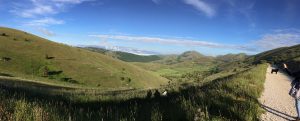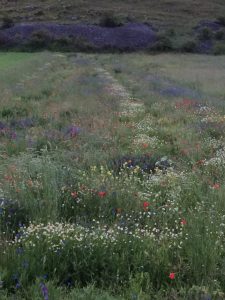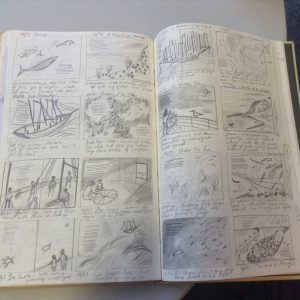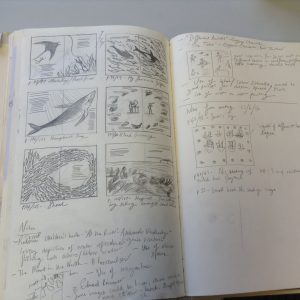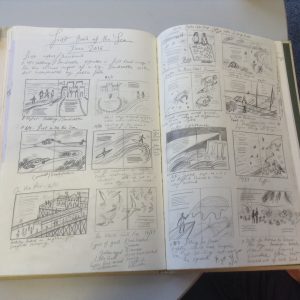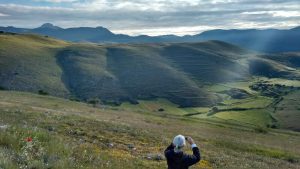 Last week I was three ways high. High in the Abruzzi mountains of Italy, up in a medieval hill top village looking out on a landscape of hobbit hills and snow streaked peaks.
Last week I was three ways high. High in the Abruzzi mountains of Italy, up in a medieval hill top village looking out on a landscape of hobbit hills and snow streaked peaks.
High on the smell and sound of the place – awash with flowers and alive with natural music, nightingales, cuckoos,frogs.
High on singing for three or more hours every day in places like this https://singingholidays.com 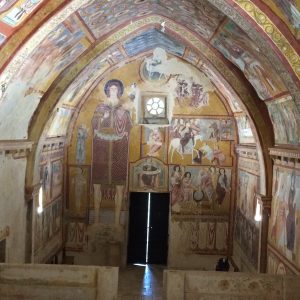
with 15 other keen singers and our wonderful course teachers Rachel and Becky Unthank http://www.the-unthanks.com
Actually, four ways high because the experience of being in close proximity to Rachel and Becky as they sang their beautiful harmonies was completely magical and transforming.
This week has been more mixed, as I’m back to the misunderstandings and crossed wires of the real world, that sometimes have me questioning if I can carry on writing at all.
First, was the e mail from a publisher asking me to make my proposal for a children’s natural history title more ‘non fiction-y’- ie more like a list. The stated reason for this request was that if fiction and non fiction are too combined, the booksellers and librarians don’t know where to put the book. This is like saying you can’t knit an orange jersey, because the shop only has yellow and red shelves.
It was a depressing request for a number of reasons:
1) anyone who knows my work, knows that combining nf and F is kind of what I’m all about. And with quite a lot of awards under my belt, more than 40 books and a track record of international sales, that seems to work.
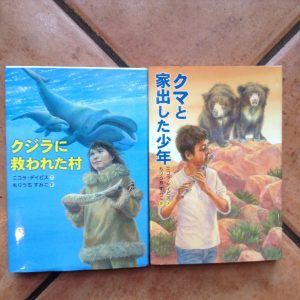
2) narrative non fiction is the new black in children’s publishing, especially as the US has now put it at the very heart of their curriculum, and finally
3) one would hope that bookshops would stock more than one copy, offering the easy solution of one on the NF shelves and one in the F shelves.
I’ve had these kind of battles all my career. I once had an editors tell me I couldn’t write about polar bears from the perspective of an Inuit because I’m not an Inuit. One priceless question in the course of that particular tussle was ‘ could you say that you had been encouraged to write this by a close personal Inuit friend?’ Presumably answering ‘yes’ would have dispelled the editor’s misgivings.
Deviate from a list of facts and some people begin to twitch. Luckily, my main publisher, Walker Books, and my wonderful long standing editor there, Caroline Royds, have pioneered narrative non fiction in the UK. They understand the magic of story space – the imaginative place created by the words and illustrations in a picture book, where the real can be combined with the imagined, to convey all manner of factual material. It is the nature of narrative that you have a narrator, and a narrative perspective – both these can be invented in non fiction and be used to contain and convey factual material.
But having to explain this again and again and again is wearing. It’s like having to constantly justify my existence. Having to fight the corner for narrative non fiction, to people who profess to want to publish it is intensely discouraging. And I’m very, very tired of it.
Happily I never have to explain to my readers, who just get it at once.
The third crossed wire was over my recent picture book Perfect
http://www.walesartsreview.org/perfect-nicola-davies-on-picture-books/
with illustrations by Cathy Fisher http://www.cathyfisher.co.uk
It was reviewed in Book for Keeps.
http://booksforkeeps.co.uk/issue/218/childrens-books/reviews/perfect-by-nicola-davies
and the reviewer really didn’t like it, because, she claimed, it presented disability as something fearful and by telling the story from the perspective of the disabled newborn’s sibling, I was denying the disabled child self determination.
Sigh.
It’s depressing when someone totally misses the point. How could I have written the story differently so that the reviewer really understood what I wanted the book to say? That initially disability can seem scary and strange; that disability does not define a person, the person defines the person; that all of us need a little help from time to time, and that helping and relying on each other is what families – and society – are all about. And that everyone, no matter what the configuration of their minds and bodies, is perfect, and perfectly loveable.
I also felt, reading that review, that the opinions expressed were exactly the reason that I wanted to write Perfect.
The reviewer seemed to be suggesting that any negative comment about disability was un acceptable, and that only the disabled were entitled to talk about disability. I think this is a very unhelpful attitude that shuts down conversations about disability and its impact on families and society. It creates a reluctance to talk naturally about disability and ultimately reinforces the imposed silence that drives people with disabilities into the shadows, and expects them to be invisible. I have watched the impact of disability on families. I’ve seen the worry, the shock, the sheer logistical hassle that the disability of a a family member can cause – it is unhelpful to deny these negative experiences. But the message of Perfect is that those negative feelings and experiences do not have to define the whole of a life: that the personhood of a disabled family member is more important than their disability and that giving them access to autonomous life, through offering a little sensible support, should be as natural as breathing.
If I break my leg, my family have to help me. Everyone has to make adjustments, but it doesn’t stop me being myself or being loved and being able to give love in return. It’s not helpful to deny the pain and inconvenience.
I’ve been hugely moved by the response of children with disabled family members, by people with disabilities and organisations representing people with disabilities. All of which have been incredibly positive. Tracy Elliot head of research at Cerebra told me the book delivered many of the messages they strive to put over. A disabled mum told me it was her children’s favourite bedtime read. I’ll hold onto those responses in my heart.
But just when I’m wondering if I’m really only fit for shelf stacking or if I should run away to sea, something good happens. Yesterday it was this, Emily Sutton’s http://www.emillustrates.com first sketches for our ‘A First Book Of The Sea’
This will be the third in a series of books of poems, following ‘A First Book Of Nature’ illustrated by Mark Hearld https://www.youtube.com/watch?v=byG6w2qaWnw and ‘A First Book Of Animals’ illustrated by Petr Horacek http://www.petrhoracek.co.uk/about.htm and out this Autumn (more about this here soon).
A first Book of the Sea is a little different from the other two – it’s about humans as well as nature and about the role that the sea plays in our lives and in our hearts. I wrote the poems last Summer,
thinking about Emily’s style as I did. It was wonderful to see so many of the images I’d imagined, and many that I could never have thought of, already dancing across the pages of Emily’s sketch book. I adore artist’s first sketches – I’ve often longed to do two editions of picture books, one with the first, free pencil marks and one with the gorgeous finished full colours.
Yesterday had a second inspiration in it too. Because of my poem ‘The Day War Came’
(and another wonderful response to that here http://www.armathwaite.cumbria.sch.uk/3000-chairs-empty-chairs-for-syrian-refugees/)
I was invited to the opening of an exhibition called ‘Drawing Our Stories’ of writing and pictures by refugees and migrants, curated by Jane Ray and Sita Brahmachari.
http://www.islingtoncentre.co.uk/events/4592555857
It was simply wonderful. I couldn’t stay for the whole event (trains to South Wales wait for no one) but I heard several of the writers and artists read, and speak about, their work.
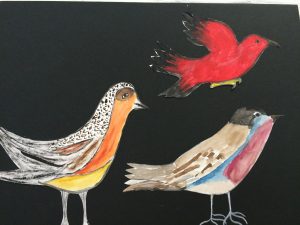
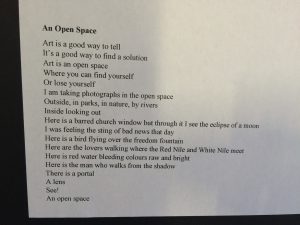
Their words were very powerful, very moving, written from the crucible of some of the most difficult experiences humans can have, being forced to leave the place where you feel you belong.
On the banks of the river stands my father
A young man then
And here we are, the next generation
Catching the stories of the Ubangi before we were born
At su set in the Summer
The river changes to yellow and purple
In my counytry
In the Congo
These colours
This river
Is caught forever
In the nets of our family memory
I was reminded of my privileged position, to be living in a peaceful country, with a passport and a nationality that matches who I feel I am; and to be able to make a life of words.
So, thanks to Emily, and the courageous writers and artists of the Islington centre for refugees and migrants, I’m humbled, untangled and recharged. I’ll keep writing. I’ll keep mixing up fiction and non fiction to try to tell truths about the world, about nature, about humanity and about how they weave and twine together through our lives. And if I have to fight for my stories, then I’ll fight.
